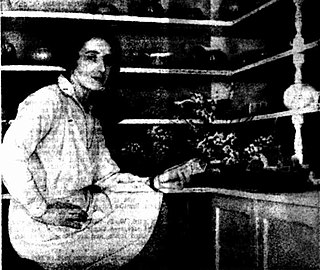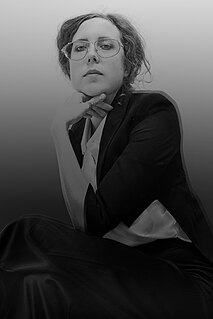Related Research Articles
Leonard Ramsay Castle was a New Zealand potter.

Studio pottery is pottery made by professional and amateur artists or artisans working alone or in small groups, making unique items or short runs. Typically, all stages of manufacture are carried out by the artists themselves. Studio pottery includes functional wares such as tableware and cookware, and non-functional wares such as sculpture, with vases and bowls covering the middle ground, often being used only for display. Studio potters can be referred to as ceramic artists, ceramists, ceramicists or as an artist who uses clay as a medium.
Deborah Halpern is an Australian sculptor, mosaic artist and ceramic artist, notable for her public artworks in Melbourne.

Gwyn Hanssen Pigott OAM (1935–2013) was an Australian ceramic artist. She was recognized as one of Australia’s most significant contemporary artists. By the time she died she was regarded as "one of the world's greatest contemporary potters". She worked in Australia, England, Europe, the USA, New Zealand, Japan and Korea. In a career spanning nearly 60 years, influences from her apprenticeships to English potters were still apparent in her later work. But in the 1980s she turned away from production pottery to making porcelain still-life groups largely influenced by the Italian painter Giorgio Morandi.
Desiderius Orban, was a renowned Hungarian painter, printmaker and teacher, who, after emigrating to Australia in 1939 when in his mid-50s, also made an illustrious career in that country.

Dame Vera Doreen Blumhardt was a New Zealand potter, ceramicist and arts educator.

Elizabeth Fritsch CBE MA (RCA) is a British studio potter and ceramic artist born into a Welsh family in Whitchurch on the Shropshire border. Her innovative hand built and painted pots are often influenced by ideas from music, painting, literature, landscape and architecture.
John Zerunge Young is a Hong Kong-born Australian artist.
Stephen Benwell is a Melbourne-based artist working predominantly in the medium of comprises ceramics. Over the course of his career his body of work has also extended into the mediums of drawing, painting and works on paper. Benwell trained as an artist in Melbourne, Australia. He received a Diploma of Art from the Victorian College of the Arts in 1974. He went onto attain a Diploma of Education from Melbourne State College in 1976 where he studied ceramics under Professor Noel John Flood. In 2005 he completed his formal education with a Masters of Fine Arts from Monash University.
Joyce Scott FRSASA 'is an Australian artist working in drawing, oil painting and ceramics.' 'She has held ten independent exhibitions, is represented internationally and has received five awards.' 'Scott, née Mottershead, was born in Poynton, Cheshire, England in 1942 and migrated with her family to Adelaide, South Australia in 1951.'
Brahmdeo Ram Pandit is an Indian studio potter and craftsman, known for his expertise in making pottery. He was honoured by the Government of India, in 2013, by bestowing on him the Padma Shri, the fourth highest civilian award, for his contributions to the field of art.

Nellie (Nell) McCredie (1901—1968) was an Australian architect and potter. One of her works Uanda is listed on the Queensland Heritage Register. Her artworks are held in a number of major Australian galleries.

Peter Reid Lange is a New Zealand ceramicist. His late brother was David Lange, former New Zealand prime minister.

Gladys Reynell (1881–1956) was one of South Australia's earliest potters and is known for her bold modernist style and her preference for working with native clays.

Dr Thancoupie Gloria Fletcher James (1937-2011) was an Australian sculptural artist, educator, linguist and elder of the Thainakuith people in Weipa, in the Western Cape York area of far north Queensland. She was the last fluent speaker of the Thainakuith language and became a pillar of cultural knowledge in her community. She was also known as Thankupi, Thancoupie and Thanakupi.
John Parker Glick was an American ceramicist. Though open to artistic experimentation, Glick was most influenced by the styles and aesthetics of Asian pottery—an inspiration that shows in his use of decorative patterns and glaze choices. His experience working with ceramics led him to publish several articles about the craft. In addition to producing pottery, Glick began making "landscape oriented" wall panels during the latter part of his career. Known as "the people's potter," he is primarily remembered for his contributions to art and the field of ceramics.
Una Deerbon (1882–1972) was an Australian studio potter in the early twentieth century. She was uniquely able as a woman potter in that period to support herself and her family.

Julia deVille is an artist, jeweller and taxidermist who only uses subjects in her taxidermy that have died of natural causes. She is an advocate for animal rights, and began including taxidermy in her art work in 2002, combining it with her jewellery making practice to produce small sculptures and installations. DeVille’s interest in memento mori traditions of the fifteenth to eighteenth centuries and Victorian mourning jewellery inform her wearable pieces.
Lewis Jarvis Harvey (1871–1949) was an artist and teacher in Brisbane, Queensland, Australia. He was an important practitioner and teacher in the arts and crafts movement in Queensland and a figure of national significance. He was an accomplished artist, carver, ceramist and sculptor, as well as the inspiration of the largest school of Art Pottery in Australia. His work appears in many churches and public buildings.
Harry Memmott (1921-1991) was an Australian ceramic pottery artist.
References
- ↑ "Famous South Australian Potter dies". The Advertiser. Retrieved 16 February 2020.
- ↑ "Milton Moon". ABC Online. 25 July 2010.
- ↑ "Milton Moon Australian Studio Potter". Ceramics Today. Retrieved 15 August 2010.
- ↑ "Milton Moon: Master of Australian Craft 2008-2010". Craft Australia. 30 November 2008. Archived from the original on 29 July 2012.
- ↑ "Milton Moon". Australian Honours Search Facility, Dept of the Prime Minister and Cabinet. Retrieved 6 November 2020.
- ↑ MILTON MOON CV, http://www.miltonmoon.com/CV.html, January 9, 2018